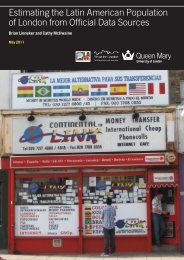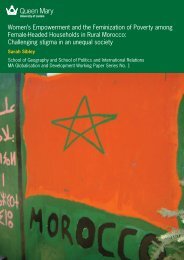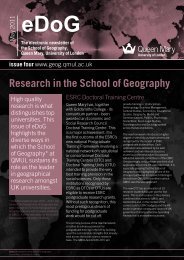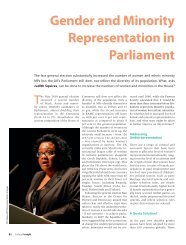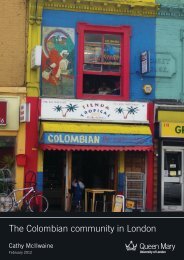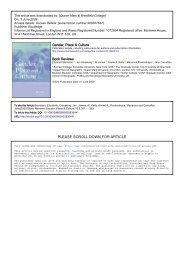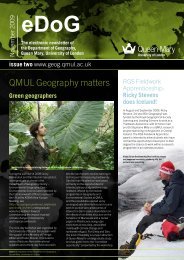Gender and Ethnic Identities among Low-paid Migrant Workers in ...
Gender and Ethnic Identities among Low-paid Migrant Workers in ...
Gender and Ethnic Identities among Low-paid Migrant Workers in ...
- No tags were found...
Create successful ePaper yourself
Turn your PDF publications into a flip-book with our unique Google optimized e-Paper software.
for women (Hondagneu-Sotelo 1999). While early research highlighted the emancipatory potential<br />
of migration for women, more recent work has been more tempered <strong>in</strong> such claims. Such work has<br />
highlighted a range of exploitative dimensions, <strong>and</strong> noted the connections between changes <strong>in</strong><br />
gender ideologies <strong>and</strong> differ<strong>in</strong>g employment histories, family <strong>and</strong> state structures <strong>and</strong> practices<br />
(Mahler 1999; Menjívar 1999), class positions <strong>and</strong> (especially) ethnicity (Willis <strong>and</strong> Yeoh 2000).<br />
Yet, while recent years have seen <strong>in</strong>creas<strong>in</strong>g recognition of the role of women <strong>in</strong> the migration<br />
process, the same period has seen a grow<strong>in</strong>g tendency to (re)marg<strong>in</strong>alize male migrants. It is also<br />
rare to consider male <strong>and</strong> female migrants together, or to explore the relational aspects of<br />
mascul<strong>in</strong>ity <strong>and</strong> fem<strong>in</strong><strong>in</strong>ity (see Gutmann 1997). Reflect<strong>in</strong>g wider patterns with<strong>in</strong> gender research<br />
that often highlights erroneous <strong>and</strong> homogenous representations of men as the ‘pathological other’<br />
or ‘custodians of patriarchy’ (Datta 2004; McIlwa<strong>in</strong>e <strong>and</strong> Datta 2004), migration research also<br />
tends to highlight “deficit” mascul<strong>in</strong>ities revolv<strong>in</strong>g around issues such as spousal <strong>and</strong> family<br />
desertion (although see Pribilsky 2004). Similarly, the role of migration as a rite of passage for<br />
adolescent men to become adults has focused on the performance of “hyper-mascul<strong>in</strong>ities” often<br />
lead<strong>in</strong>g to gender violence, <strong>and</strong> the fact that men left beh<strong>in</strong>d are viewed as failures who do not take<br />
over reproductive roles (Boehm 2004), a view that is now be<strong>in</strong>g challenged (Manalansan IV 2006).<br />
The need, therefore, is for a more systematic analysis of how migration creates new gendered<br />
conventions <strong>and</strong> challenges for both women <strong>and</strong> men. Central to this is an appreciation that gender<br />
is a relational <strong>and</strong> fluid construction, permeated by a range of different hierarchies of power.<br />
Clearly, gender relations are crosscut by other cleavages such as race, ethnicity, nationality, class,<br />
age <strong>and</strong> sexuality. At the same time, ethnicity <strong>and</strong> nationality too are constitutive of, <strong>and</strong> constituted<br />
by, migration. This is partly evidenced <strong>in</strong> the flows <strong>and</strong> patterns of transnational migration. With<strong>in</strong><br />
specific ethnic communities, men <strong>and</strong> women may also perform different roles – with women<br />
sometimes particularly valued as bearers of tradition <strong>and</strong> culture: as ‘ethnomarkers’ charged with<br />
the responsibility of pass<strong>in</strong>g on values <strong>and</strong> customs (Yeoh <strong>and</strong> Willis 2004). By the same token,<br />
ethnic traditions may reproduce patriarchal conventions which are harmful for women.<br />
These complex processes are played out, <strong>and</strong> affected by, “different scales <strong>and</strong> transnational<br />
spaces” (Pessar <strong>and</strong> Mahler 2003: 822) such that gender identities, ideologies <strong>and</strong> practices are<br />
formulated, challenged, <strong>and</strong> negotiated <strong>in</strong> manifold ways as people move across borders <strong>and</strong><br />
ma<strong>in</strong>ta<strong>in</strong> ties with their home country <strong>in</strong> what have become transnational social spaces (Fouron <strong>and</strong><br />
Glick-Schiller 2001; Mahler 1999; Pessar 2005). Thus, accord<strong>in</strong>g to Vertovec (2001: 578), ‘the<br />
5







